Research Article
An Experimental Study to Assess the Effectiveness of Progressive Muscle Relaxation Techniques on Physiological Parameters of Pregnancy Induced Hypertension among Antenatal Mothers at Selected Hospitals of Jabalpur City
6907
Views & Citations5907
Likes & Shares
Hypertensive disorders of pregnancy occur in about 10% of all pregnant women around the world. Preeclampsia affects 3-5% of pregnancies. Relaxation therapy provides a decrease in sympathetic nervous system allowing the arteries to widen and increases the available oxygen and blood flow to the body tissues and the bringing the vital parameters of preeclampsia to normal condition.
INTRODUCTION
“Motherhood Is a Gift of God to Women”-Mother Teresa Woman who is considered the guardian of the respect and honor of a family. Moreover, God has already emancipated woman for no responsibility can be greater than that of continuing the cycle of life of birth. Pregnancy induced hypertension is one of the extensively present disease today. Whereby, pregnancy induced hypertension is the 2nd leading cause of death in developed countries and 4thleading cause of death in the developing countries.
Preeclampsia is one of the hypertensives (high blood pressure) disorders of pregnancy. It is a major cause of maternal and perinatal mortality (number of stillbirths and deaths of newborn in the first week of life) and morbidity. Along with preeclampsia, other diseases which are included in the group of hypertensive disorders of pregnancy are eclampsia, gestational hypertension and chronic hypertension. In India, the incidence of preeclampsia is reported to be 8-10% among the pregnant women. According to a study, the prevalence of hypertensive disorders of pregnancy was 7.8% with preeclampsia in 5.4% of the study population in India. [1]
Preeclampsia is a pregnancy specific hypertensive disease with multisystem involvement. It is a disorder of widespread vascular endothelial malfunction and vasospasm that occurs after 20 weeks of gestation and can present as late as 4-6 weeks postpartum (after childbirth). According to the new guidelines given by American congress of obstetricians and gynecologists (ACOG) in 2013, the diagnosis of preeclampsia does not require the detection of high levels of protein in the urine (proteinuria) along with hypertension [2].
In developing countries, a woman is seven times as likely to develop preeclampsia than a woman in a developed country. From 10-25% of these cases will result in maternal death. Maternal mortality worldwide dropped by almost 50%. Approximately 25% of all pregnancy- and childbirth-related maternal deaths globally occur in India [3].
According to the pregnancy and childbirth among women in the age group of >30 years contribute to the complications to the highest level in the past 3 decades. A prospective study in India was conducted to determine the prevalence of pregnancy induced hypertension among 400 pregnant mothers; the study findings revealed that the overall prevalence of pregnancy induced hypertension was 27% [4]. Globally high blood pressure problems occur in 6 to 8% of all pregnancies, about 70% of which are first-time pregnancies. Various forms of relaxation therapies have been found to benefit patients in diverse ways. Physiologically, relaxation helps in the reduction of sympathetic nervous system excitation that marks the fight or flight response and decreases the level of stress. Simply relaxing for 15 to 20 min twice or thrice daily results in lowered levels of adrenaline, cortisol, blood pressure, heart rate, and respiratory rate, which enhance the immune function and balance the activity in the right and the left hemispheres of the brain [5].
In a state of relaxation, various physical phenomenon occurs which are accompanied by a sense of response and pleasure. These feelings reinforce emotional stability because in a state of relaxation we react calmly and reasonably and adjust more easily to new situations. Our disposition is therefore more stable and we are less given to mood change.
Jacobson’s Progressive Relaxation Technique
Jacobson’s relaxation technique is a type of therapy that focuses on tightening and relaxing specific muscle groups in sequence. It’s also known as progressive relaxation therapy. By concentrating on specific areas and tensing and then relaxing them, you can become more aware of your body and physical sensations. The technique involves tightening one muscle group while keeping the rest of the body relaxed, and then releasing the tension [6].
It’s a 15-20 min to complete this relaxation technique. It involves tensing and releasing different muscle groups. It first began with guided instructions for slow, paced breathing. It can reverse stress thereby preventing many health hazards. Practicing relaxation and meditation will decrease heart rate and respiratory rate and normalizes blood pressure and uses less oxygen more effectively for the body function.
The neural pathways of the sympathetic and the parasympathetic system guide the function of the stress response and the relaxation response. Through a training process involving relaxation exercises, the patient learns to regulate a balance in these pathways. Relaxation works through psycho-physiological means implying that both the mind and the body are involved in the quieting process. Progressive muscle relaxation training focuses on the muscle groups and allows them to relax. And is an easily learned procedure.
Apart from the side effects of antihypertensive, relaxation techniques and rest in hospital or home setting is helpful for continued evaluation and treatment of patient. This will increase the blood flow promoting dieresis, increases uterine blood flow and improve placental perfusion and reduce blood pressure. Relaxation exercises are simple, safe or economic. They help in preventive and promotive aspects of health and illness whereas long term drug consumption for hypertension can have side effects upon human system and it also involve heavy cost.
OBJECTIVES OF THE STUDY WERE
- Assess the physiological parameters of pregnancy induced hypertension among antenatal mothers in control &experimental group.
- Assess the physiological parameters of pregnancy induced hypertension among antenatal mothers in experimental group after administration of progressive muscles relaxation techniques.
- Evaluate the effectiveness of the progressive muscles’ relaxation techniques on level of physiological parameters among antenatal mothers in experimental group.
- Compare the level of physiological parameters of pregnancy induced hypertension among antenatal mothers in control and experimental group.
- Associate effectiveness the level of physiological parameters with selected demographic variables in control group.
- Associate effectiveness the level of physiological parameters with selected demographic variables in experimental group.
Hypotheses
All Hypotheses were tested at p
- H1-There will be a significant mean difference between physiological parameters of pregnancy induced hypertension among antenatal mothers in experimental group before and after administration of progressive muscle relaxation technique.
- H2-There will be a significant mean difference in physiological parameters of pregnancy induced hypertension in control and experimental group.
- H3-There will be significant association between physiological parameters with the selected demographic variables in control group.
- H4-There will be significant association between physiological parameters with the selected demographic variables in experimental group.
Operational definitions
- Assess: In this study assess is referred as the statistical measurements of all physiological parameters of pregnancy induced hypertension among antenatal mothers as determined by the various scale that blood pressure is measured by WHO/ISH -blood pressure classification for pregnancy induced hypertension (2009), weight measured by WHO(World Health Organization) criteria for weight assessment, edema is assessed by edema 4 point scale, proteinuria is measured by 5 point scale- source- American society of nephrology [7].
- Effectiveness: In this study the effectiveness refers to the efficiency of administration of progressive muscle relaxation technique on assessment of physiological parameters of pregnancy induced hypertension in antenatal mothers.
- Progressive Muscle Relaxation Technique: In this study progressive muscle relaxation technique is a type of therapy that focuses on tightening and relaxing specific muscle groups in sequence. It’s also known as Jacobson progressive relaxation technique. By concentrating on specific areas and tensing and then relaxing them, can become more aware of body and physical sensations. The technique involves tightening one muscle group while keeping the rest of the body relaxed, and then releasing the tension.
In this study it refers to the following-muscle relaxation technique is administered for a period of 15 min, two times in a day for 7 days, which includes: -
Duration: Requires 15 min for each session Interval - 10 s for contraction, 5 s for relaxation repeating 3 min for each body parts.
Whole-body technique
It recommends beginning the relaxation therapy with a breathing exercise and then moving from the feet up. She suggests the following exercises:
This exercise requires 10 s for contraction, 5 s for relaxation.
- Feet-This exercise requires 10 s for contraction, 5 s for relaxation repeating for 3 min. Bring the attention to feet. Point feet downward, and curl the toes under. Tighten toe muscles gently, but don’t strain. Notice the tension for a few moments, then release, and notice the relaxation. Repeat. Become aware of the difference between the muscles when they’re tensed and when they relaxed. Continue to tense and relax the leg muscles from the foot to the abdominal area.
- Abdomen-This exercise requires 10 s for contraction, 5 s for relaxation repeating for 3 min.
Gently tighten the muscles of abdomen, but don’t strain. Notice the tension for a few moments. Then release, and notice the relaxation. Repeat. Become aware of the difference between the tensed muscles and the relaxed muscles.
- Shoulders and neck - This exercise requires 10 s for contraction, 5 s for relaxation repeating for 3min.
Very gently shrug your shoulders straight up towards ears. Don’t strain. Feel the tension for a few moments, release, and then feel the relaxation. Repeat. Notice the difference between the tensed muscles and the relaxed muscles. Focus on the neck muscles, first tensing and then relaxing until feel total relaxation in this area.
- Hand - This exercise requires 10 s for contraction, 5 s for relaxation repeating for 3min.
Close the hands tightly to feel the tension. Hold for 10 s, and slowly allow the fingers to release one by one until they’re completely relaxed.
- Localized technique - This exercise requires 10 s for contraction, 5 s for relaxation repeating for 3 min.
Press lips tightly together and hold for 5 s, feeling the tension. Slowly release. The lips should be completely relaxed and barely touching after the release. Finally, press the tongue against the roof of mouth for 5 s and notice the tension. Slowly relax the tongue until it’s sitting on the floor of the mouth and jaws are tightly closed (Figure 1).
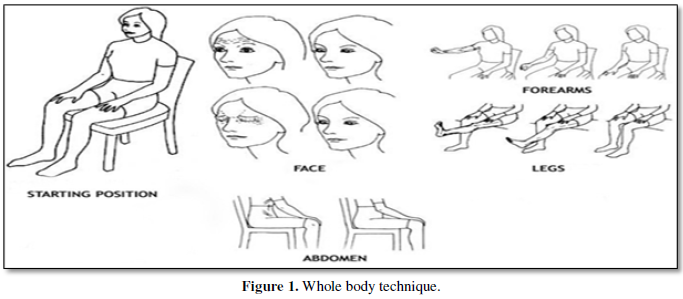
- Physiological parameters–In this study the physiological parameters of pregnancy induced hypertension are assessed which includes blood pressure, weight, edema, proteinuria. Where will be assessed 2 times during intervention in which 1st assessment is done on 4th day and 2nd assessment is done on 7th
- Pregnancy Induced Hypertension– In this study pregnancy induced hypertension is a condition characterized by high blood pressure, weight, edema, proteinuria during 2nd& 3rd trimester of pregnancy.
- Antenatal mothers – In this study the mother who is primigravida in 2nd and 3rd trimester that having pregnancy induced hypertension and admitted in maternity ward in selected hospital of Jabalpur city.
Delimitations of the study
The study was delimited to 60 subjects. The study was delimited to the subjects that are 30 in control group and 30 in experimental group. The delimited times of 1 month were available of data collection. The study was limited to mother who at 12-36 weeks of gestational age.
The conceptual framework
For this study is based on Wiedenbachs prescriptive theory.
METHODOLOGY
Research approach
In this study a quantitative & evaluative research approach was used to evaluate the effectiveness of progressive muscle relaxation during antenatal mothers to assess physiological parameters of pregnancy induced hypertension in maternity ward of selected hospitals in Jabalpur city.
Research design
In this study, the investigator selected quasi experimental research design, in which two group pre-test post-test design to observe the effectiveness of muscle relaxation techniques among pregnancy induced hypertension among antenatal mothers.
The population in this study consist of population consisted of antenatal mothers admitted in the antenatal wards of selected hospitals at Jabalpur city.
In the study the sample size constitutes of 60 antenatal mothers from selected hospitals of Jabalpur city which fulfilled the sample criteria.
- 30 sample in control group
- 30 sample in experimental group
Sampling technique
Sampling technique is the selection of a subset (a statistical sample) of individuals from within a statistical population to estimate characteristics of the whole population. Statisticians attempt for the samples to represent the population in question [8].
The subjects of the study will be selected by using non-probability purposive sampling technique according to inclusive criteria as availability of subjects.
Inclusion criteria
Inclusion criteria are a set of predefined characteristics used to identify subjects who will be included in a research study.
Antenatal mothers
- Who are having pregnancy induced hypertension
- Who were at the second and third trimester of gestation
- Who can perform this exercise
- Who were having 12 -36 weeks of gestation
Exclusion criteria
In the context of a clinical trial, any characteristic in the study that would preclude a potential subject’s participation in the study.
Antenatal mothers
- Who do not want to participate and practice progressive muscle relaxation therapy
- Who are having problems regarding pulled muscles, broken bones, or any medical contraindication for physical activities
- Who receives any other alternative therapy
- Who are not willing to participate in the study
Tool
The tools used in this study are:
- Section I: demographic data of antenatal mothers.
- Section II: assessment of physiological parameters.
A scale was modified to assess the demographic variables and physiological parameters (blood pressure, weight, edema, proteinuria) measurement was done to assess the effectiveness of progressive muscle relaxation technique among antenatal mothers with pregnancy induced hypertension.
- Blood pressure measured by digital sphygmomanometer (Table 1)
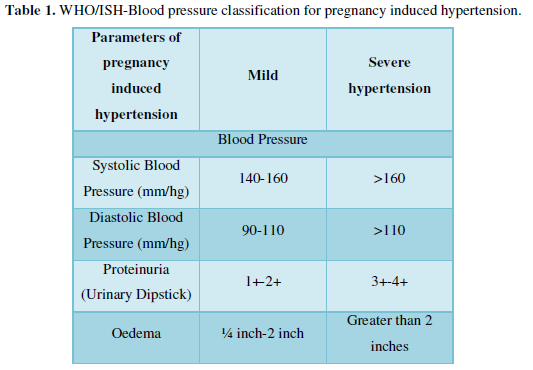
2. Edema is assessed by edema 4-point scale by finger and scale Source-National Health Mission (Table 2).
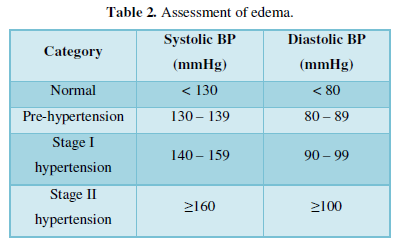
3. Proteinuria is measured by 5-point scale by dipstick (Urocolor2)- Source- American Society of Nephrology (Table 3)
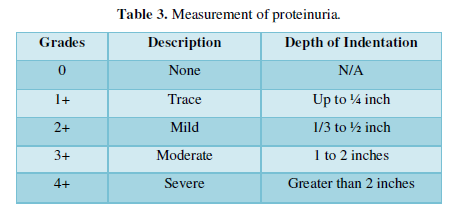
4.Weight is measured by weight machine-WHO criteria for weight assessment (Table 4).
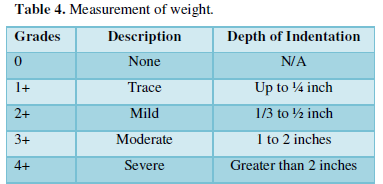
The reliability was calculated and obtained value was r=0.84 which showed that the tool was reliable.
Organization and presentation of data
The data were analyzed and interpreted using descriptive and inferential statistics. The data Were organized and presented under the following headings.
- Section I:
- Section I (A): It deals with the analysis of the demographic data of the subjects of control group.
- Section I (B): It deals with the analysis of the demographic data of the subjects of experimental group.
- Section II: It deals with the analysis of physiological parameters of pregnancy induced hypertension of the control group.
- Section III: It deals with the analysis of physiological parameters of pregnancy induced hypertension after administrating the Progressive muscle relaxation technique in experimental group.
- Section III (A): Pre-test score before administrating the Progressive muscle relaxation technique to experimental group.
- Section III (B): Post-test score after administrating the Progressive muscle relaxation technique to the experimental group.
- Section III (C): Comparison between pre-test post-test score physiological parameters after administrating the Progressive muscle relaxation technique in experimental group.
- Section IV: It deals with the analysis of data to assess the effectiveness by comparing Physiological parameters of pregnancy induced hypertension between control and experimental group.
- Section V:
- Section V (A): It deals with the data to find out association between physiological parameters with selected demographic variables in control group.
- Section V(B): It deals with the data to find out association between physiological parameters with selected demographic variables in experimental group.
RESULTS
Tables 5-16 and Figure 1
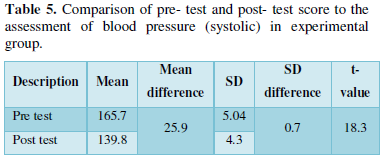
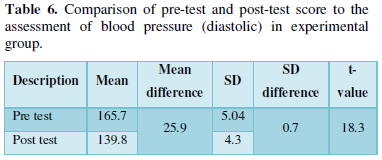
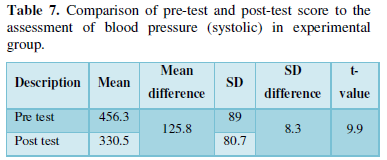
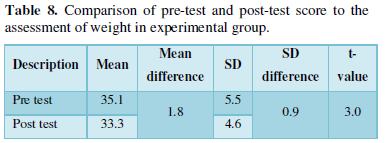
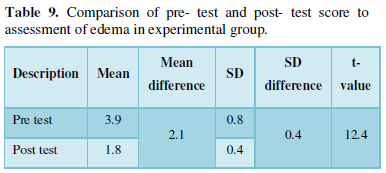

















ASSOCIATION
Significant association was found of age, education, occupation, Height, Weight, Family Income, Type of Family, family history, Marital Life, Antenatal Visits, Information Related to progressive muscle relaxation technique, nature of case in control group. None of them was found to be non-significant.
CONCLUSION
Nursing is an art and science. As a science, nursing is based upon a body of knowledge that is always changing with new discoveries and innovations. Keep in pace with the changing trends so as to provide adequate information and guidance to mothers with Pregnancy induced hypertension mothers in order to prevent complications. Train the staff nurses to teach progressive muscle relaxation technique to the mothers with Pregnancy induced hypertension as a part of their daily routine. Encourage the use of progressive muscle relaxation technique along with other complementary therapies to reduce blood pressure in various settings.
According to the annual statistics of IMCH (2007), the total number of pregnancies induced hypertension in IMCH Kozhikode is 1719 (7.5%). Among these cases, mild hypertension is 1376, severe hypertension 198, hypertension 42 complicating pregnancy 55, eclampsia 59, help 29 and acute fatty liver of pregnancy 2 cases [9].
The nurse especially nurse midwives aware of it by in-service education program and inter disciplinary. Hence the nurse should have adequate knowledge about these modalities to improve the standards of maternity care. The adoption of the physiological management approach requires that mothers accept and progress normally, the pattern of progression positively reinforce nursing care support bearing dawn efforts and the midwives should concern for it use. Thus, there is a need to implement research findings in the clinical field, so as to avoid the wide gap between research studies and clinical practice.
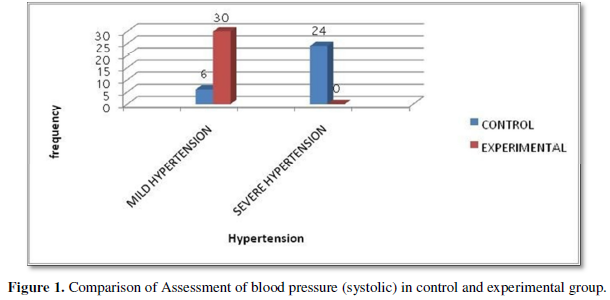

Encourage and educate the student nurses to gain skills in practicing Benson’s relaxation therapy on effective control of blood pressure. Progressive muscle relaxation technique can be included as a part of complementary therapies in nursing curriculum. Nursing administration can depute nurses for various workshops, conferences and special courses and also in-services education programmes can be arranged for nursing staff.
Pregnancy induced hypertension is a chronic illness which is developed only during pregnancy. It can be controlled by regulation of diet, relaxation by avoiding stress, early identification and medication, monitoring blood pressure level, rest, and Urine testing for the presence of albumin and by making some adjustment in life styles [10].
The relationship between hypertension in pregnancy and poor maternal and fetal outcome had long been recognized and the thrust of prenatal care is laid on improving the pregnancy outcome associated with pregnancy induced hypertension. It is acknowledged that techniques of relaxation and deep breathing go a long way in preparing pregnant women to cope with challenges and discomforts associated with child birth.
- National centre for health statistics (2012) Prevalence of PIH.
- National High BP Education program working group (NHBPEP) (2002) The American College of obstetricians and gynaecologists (ACOG) HT in pregnancy (NHBPEP 2000) ACOG (2002, 2013) ACOG; Chronic HT and pregnancy. Practice bulletin; Washington ACOG. pp: 29.
- Preethijazna B, Kumari R, Nalinijeyavanthasantha (2016) Quasi experimental conducted by on a study to assess the effectiveness of Benson relaxation therapy on blood pressure and stress among women with pregnancy induced hypertension in selected hospitals, Madurai. FOGSI publication.
- Pradhan P (2009) A prospective study in India was conducted to determine the prevalence of pregnancy induced hypertension, National centre for Health Statistics.
- Shennan AH, Waugh J (2003) Measurement of BP and proteinuria in pregnancy. In preeclampsia. London: RCOG. pp: 305-324.
- Jacobs GD (2001) Clinical applications of relaxation responses and mind body interventions. J Altern Complement Med 7 Suppl 1: S93-101.
- World Health Organization (2001) Reduction of maternal mortality: A join WHO/ UNFPA / UNIEF/ World Bank statement.
- Polit DF Hungler BP (2001) Nursing Research, Principles & Methods. 6th Philadelphia: J B Lippincott Company. pp: 223-225.
- Paily VP (2004) Confidential series of maternal deaths (CMRD) Kerala. Kerala federation of obstetrics and gynaecology 22: 1.
- Mani S (2003) A protocol on nursing management of pregnancy induced hypertension based on learning needs of nurses and nursing needs of women with PIH in a selected hospital of Kolkata, West Bengal dissertation). Manipal: Manipal Academy of Higher Education Deemed University.
QUICK LINKS
- SUBMIT MANUSCRIPT
- RECOMMEND THE JOURNAL
-
SUBSCRIBE FOR ALERTS
RELATED JOURNALS
- Food and Nutrition-Current Research (ISSN:2638-1095)
- Journal of Biochemistry and Molecular Medicine (ISSN:2641-6948)
- Journal of Microbiology and Microbial Infections (ISSN: 2689-7660)
- Proteomics and Bioinformatics (ISSN:2641-7561)
- Journal of Genomic Medicine and Pharmacogenomics (ISSN:2474-4670)
- Advances in Nanomedicine and Nanotechnology Research (ISSN: 2688-5476)
- Journal of Agriculture and Forest Meteorology Research (ISSN:2642-0449)




